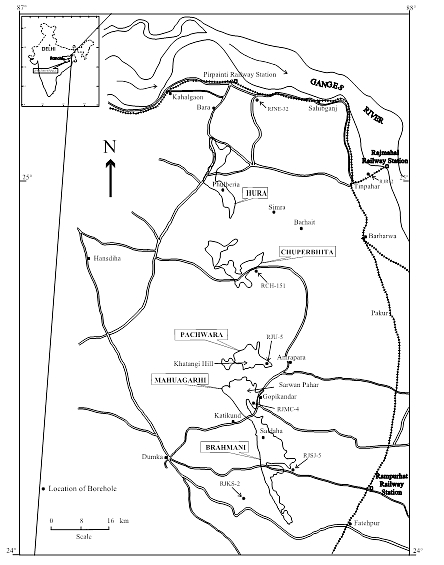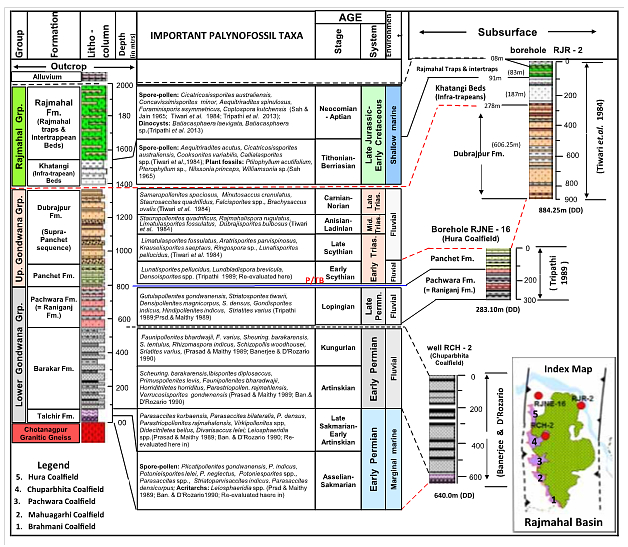Dubrajpur Fm
Type Locality and Naming
Rajmahal Basin: Named after the village Dubrajpur, Jharkand by Oldham (1860) as Upper Damuda Series, was later referred as Dubrajpur Group by Oldham (1862). The status of formation to Dubrajpur unit was given by Sah and Shah (1974). Sarwan Pahar section located close to Dubrajpur village is the amended type Section (Sen Gupta, 1985, 1988), with reference sections as Khatangi Hill Section (Sah, 1965) and Chaparia Pahar section (Sen Gupta, 1988). The Narganj-Sudra section earlier designated as type section by Sah and Shah (1974) was discarded by Sen Gupta (1985, 1988) as Narganj is situated on the outcrop of Archean granite and not on the Dubrajpur Formation, and Sudra is obscure lacking description.
[Original Publication: Oldham, T., 1860. On the geological relations and probable geological age, of the several systems of rocks in central India and Bengal. Memoir of the Geological Survey of India, 2, 299-335; Oldham, T., 1862. Introductory Remarks. In: Oldham, T. and Morris, I. Fossil flora of the Rajmahal Series, Rajmahal Hills, Bengal. Mem. Geol. Surv. India, Palaeont. Indica, Ser. 2, pt. 1, 1-8; Sah, S.C.D., 1965. Palaeobotanical evidences on the age of the Khatangi Beds (?Dubrajpur) in the Rajmahal Hills, Bihar. The Palaeobotanist, 13, 218-221; Sah, S.C.D., Shah, S.C., 1974. Dubrajpur Formation and its biozones. In: Surange, K.R., Lakhanpal, R.N. and Bharadwaj, D.C. (eds.), Aspect and Appraisal of Indian Palaeobotany. Birbal Sahni Institute of Palaeobotany, Lucknow, p. 447-451; Sen Gupta, S., 1985. Dubrajpur Formation and its type section from Rajmahal Hills, India. Record of the Geological Survey of India, 113(3), 99-105; Sen Gupta, S., 1988. Upper Gondwana stratigraphy and palaeobotany of Rajmahal Hills, Bihar, India. Geological Survey of India, Palaeontologia Indica, 48, 1-182]
[Figure 1: Location map of Sarwan Pahar and Khatangi Hill, Rajmahal coal fields]
Lithology and Thickness
Sandstone. Pink, coarse-grained sandstone, pebbly at the base, is overlain by white sandy shale, grey shale and white to light grey fine-sandstone showing baking effects at the top. The formation is about 123.4 m thick in type section (Sen Gupta, 1985).
[Figure 2: Lithological units of the type (A) and reference (B) sections of the Dubrajpur Formation in the Rajmahal Basin (after Sengupta, 1984; 1985 and Tripathi & Ray, 2006)]
Relationships and Distribution
Lower contact
The presence of pebbly sandstone at the base suggests a break in sedimentation between the underlying Barakar Fm and overlying Dubrajpur Fm. Along the western scarp of the Rajmahal hills, where the Barakar Fm is absent, Dubrajpur Formation rests over the Talchir Fm or over the Precambrian Granite-gneiss.
Upper contact
The Dubrajpur Formation is overlain by the Rajmahal Traps Fm. The upper contact of the Dubrajpur Formation with the Rajmahal Traps Fm is often baked by the heat of overlying lava flows (Sen Gupta, 1988).
Regional extent
Rajmahal Basin: The Dubrajpur Formation occurs as a narrow discontinuous strip skirting the Rajmahal Trap in the western margin of Rajmahal Hills. The formation is well exposed in Mohuuagarhi Hill, Kunda Pahar, Sundar Pahari, southeast of Susnia, north of Bargo, east and southeast of Goradih near Angbali, around Lawdih, Khelari Hill, Khangi Hill and Swarn Pahar (source Sastry et al., 1977; Peters, 2009).
GeoJSON
Fossils
Flora: Gleichenites gleichenoides, Culcitites madagascariensis, Cladophlebis indica, Sphenopteris sp., Pecopteris sp., Microphyllopteris sp., Onychipopsis sp., Thinnfeldia khatangiensis, Ptilophyllum acutifolium, P. cutchense, Pterophyllum distans, P. footeanum, P. fissum, Williamsonia sp., Nilssonia princeps, Nilssonia sp., Macrotaeniopteris lata, Ctenis rajmahalensis, Taeniopteris oldhamii, T. crenata, Otozamites sp., Pagiophyllum sp., and Elatocladus conferta (Srivastava, 1958; Sah, 1965; Sen Gupta, 1988; Banerji, 1990). Palynozones – Contignisporites cooksoniae and Murospora florida (Vijaya and Sen, 2005); Unio (Hobson, 1928).
Age
Depositional setting
Dubrajpur Formation containing conglomerate, sandstone, shale are braided river deposits. The paleocurrent vectors indicate a northerly paleo-slope (Veevers and Tewari, 1995). The dominance of cycadophytes over conifers indicates that a tropical to subtropical climate was prevailing at the time of deposition (Banerji, 1990).
Additional Information
References
Banerji, J., 1990. Plant fossils from Dubrajpur Formation, Bihar their significance in stratigraphy. In: Jain, K.P., and Tiwari, R.S. (eds.), Proceedings of a Symposium on Vistas in Indian Palaeobotany. Palaeobotanist, 38, 122-130. . Banerji, J., 2000. Megafloral diversity of the upper Gondwana sequence of the Rajmahal Basin, India. Journal of African Earth Sciences, 31, 133-144. Hobson, G.V., 1928. General Report. Record of the Geological Survey of India, 62, 145-147. Mukhopadhyay, G., Mukhopadhyay, S.K., Roychowdhury, M., Parui, P.K., 2010. Stratigraphic correlation between different Gondwana basins of India. Journal Geological Society of India, 76: 251-266. Oldham, T., 1860. On the geological relations and probable geological age, of the several systems of rocks in central India and Bengal. Memoir of the Geological Survey of India, 2, 299-335. Oldham, T., 1862. Introductory Remarks. In: Oldham, T. and Morris, I. Fossil flora of the Rajmahal Series, Rajmahal Hills, Bengal. Mem. Geol. Surv. India, Palaeont. Indica, Ser. 2, pt. 1, 1-8. Peters, J., 2009. Prasad, B. & Pundir, B. S. 2020. Gondwana biostratigraphy and geology of West Bengal; basin, and its correlation with adjoining Gondwana basins of India and western Bangladesh. Jour. Earth Syst. Sci. (2020) 129 22 https://doi.org/10.1007/s12040-019-1287-2. Sah, S.C.D., 1965. Palaeobotanical evidences on the age of the Khatangi Beds (?Dubrajpur) in the Rajmahal Hills, Bihar. The Palaeobotanist, 13, 218-221. Sah, S.C.D., Shah, S.C., 1974. Dubrajpur Formation and its biozones. In: Surange, K.R., Lakhanpal,R.N. and Bharadwaj, D.C. (eds.), Aspect and Appraisal of Indian Palaeobotany. Birbal Sahni Institute of Palaeobotany, Lucknow, p. 447-451. Sastry, M.V.A., Acharyya, S.K., Shah, S.C., Satsangi, P.P., Ghosh, S.C., Raha, P.K., Singh, G., Ghosh, R.N. 1977. Stratigraphic lexicon of Gondwana formations of India. Geol. Surv. India, Misc. Publ. 36: 1-170. Sen Gupta, S., 1985. Dubrajpur Formation and its type section from Rajmahal Hills, India. Record of the Geological Survey of India, 113(3), 99-105. Sen Gupta, S., 1988. Upper Gondwana stratigraphy and palaeobotany of Rajmahal Hills, Bihar, India. Geological Survey of India, Palaeontologia Indica, 48, 1-182. Srivastava, 1958. Tripathi, A., Ray, A. 2006. Palynostratigraphy of the Dubrajpur Formation (Early Triassic to Early Cretaceous) of the Rajmahal Basin, India. Palynology, 30, 133-149. Veevers, J.J., Tewari, R.C., 1995. Gondwana Master Basin of Peninsular India between Tethys and the Interior of the Gondwanaland Province of Pangea. Geological Society of America Memoir 187, 1-72. Vijaya and Sen, K.K., 2005. Palynological study of the Dubrajpur Formation in the Mesozoic succession, Pachami area, Birbhum coalfield, West Bengal. Pal. Soc. India 50(1), 121-133.

 and reference (B) sections of the Dubrajpur Formation.jpg)
